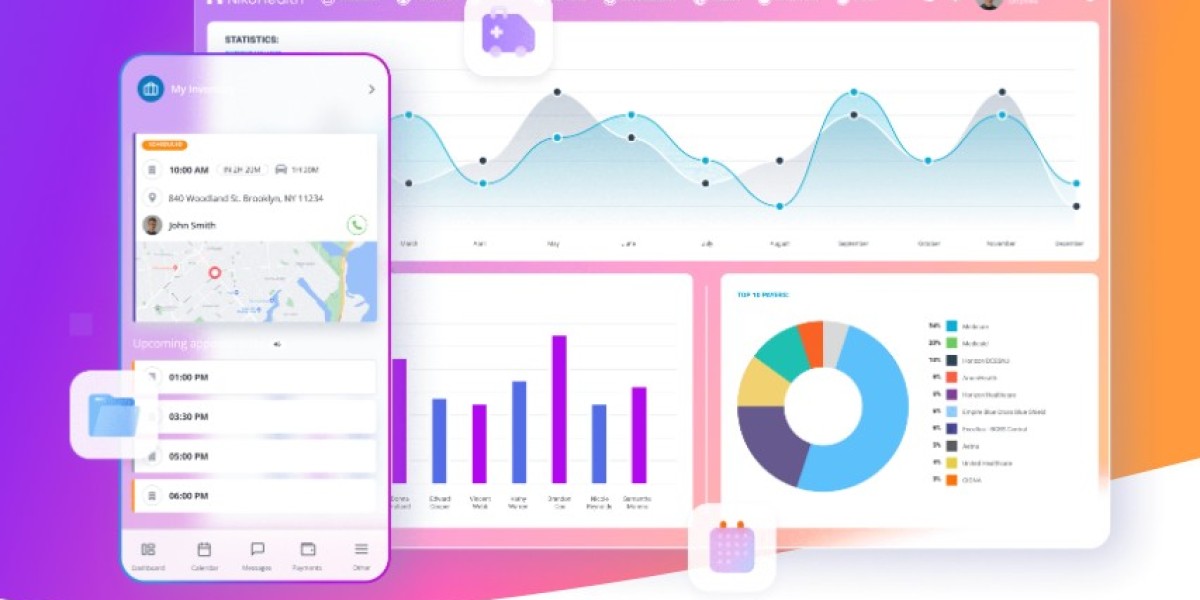Introduction
In the healthcare industry, Durable Medical Equipment (DME) plays a crucial role in improving patient care and enhancing the quality of life for individuals with chronic illnesses or disabilities. DME includes essential medical devices such as wheelchairs, oxygen tanks, hospital beds, and mobility aids that help patients maintain their independence. However, managing the billing and reimbursement process for these items can be complex and time-consuming. This is where DME billing software comes into play, offering an efficient solution to streamline the process and ensure accurate, timely payments.
In this article, we will explore the essential features, benefits, and challenges of DME billing software, as well as how it impacts the operational efficiency of healthcare providers and DME suppliers.
What is DME Billing Software?
DME billing software is a specialized tool designed to automate and manage the billing and claims submission process for durable medical equipment. This type of software ensures that the DME provider is reimbursed by insurance companies, Medicare, Medicaid, and other third-party payers for the equipment they supply to patients. The software typically handles a range of tasks, including:
- Creating and submitting claims electronically
- Ensuring compliance with industry regulations (e.g., HIPAA)
- Managing patient records and insurance details
- Tracking claim status and payments
- Handling appeals and denials
With its ability to streamline administrative tasks, DME billing software reduces human error, accelerates the reimbursement process, and improves cash flow for providers.
Key Features of DME Billing Software
Automated Claims Submission: The software simplifies the process of submitting claims electronically to payers, significantly reducing the manual workload for staff. It automatically checks claims for errors before submission, which reduces the likelihood of denials or delays in payment.
Compliance and Regulation Management: Compliance with Medicare, Medicaid, and other insurance regulations is critical for DME providers. The software ensures that claims are in line with the latest healthcare billing regulations, reducing the risk of penalties and ensuring compliance with HIPAA (Health Insurance Portability and Accountability Act) standards.
Real-Time Claim Tracking: One of the most valuable features of DME billing software is the ability to track the status of claims in real-time. This helps providers quickly address issues like claim rejections, denials, or payment delays, allowing for faster resolution and cash flow optimization.
Patient Management: DME billing software typically includes a patient management module where providers can store and access patient data, including medical history, prescriptions, insurance details, and more. This feature enables better coordination between the billing process and patient care.
Inventory Management: Many DME billing systems also integrate inventory management capabilities, allowing providers to track the availability of equipment, manage restocking, and ensure timely delivery of equipment to patients.
Denial Management: Denied claims are common in the DME industry due to the complexity of insurance requirements. DME billing software includes denial management tools that help providers identify the reasons for denials and take corrective actions. The software can also resubmit corrected claims automatically.
Electronic Remittance Advice (ERA): ERA allows providers to receive remittance information electronically from payers, streamlining the reconciliation process. This feature makes it easier to track payments, process refunds, and maintain accurate records.
Reporting and Analytics: Detailed reporting and analytics features help providers gain insights into their financial performance, such as claims success rates, reimbursement timelines, and overall revenue. These insights help in making informed business decisions and identifying areas for improvement.
The Benefits of DME Billing Software
1. Improved Accuracy and Reduced Errors
Manual billing processes are prone to human errors, such as incorrect coding, missing documentation, and outdated patient information. These mistakes can result in claim denials and delays in payment. DME billing software automates the claims submission process, ensuring that the correct codes and documentation are used. This significantly reduces errors and improves the likelihood of claims being approved on the first submission.
2. Increased Efficiency
Automating the billing process allows DME providers to focus more on patient care rather than administrative tasks. The software reduces the time spent on manual data entry, claim submission, and follow-up, enabling staff to handle more claims in less time. This leads to faster reimbursement and improved cash flow for the business.
3. Compliance with Industry Regulations
DME providers must comply with a variety of regulations, including those set by Medicare and Medicaid. Non-compliance can result in fines, penalties, or even exclusion from participating in insurance programs. DME billing software ensures that all claims adhere to current regulations, helping providers avoid costly mistakes and maintain their eligibility for reimbursement.
4. Faster Reimbursement
Timely reimbursement is critical for the financial health of DME providers. By automating the claims process and reducing errors, DME billing software accelerates the reimbursement timeline. Real-time claim tracking also allows providers to identify issues quickly and take corrective action, ensuring that payments are received as soon as possible.
5. Better Denial Management
Dealing with denied claims can be a significant challenge for DME providers. Denied claims not only slow down revenue collection but also require additional resources to correct and resubmit. DME billing software simplifies denial management by identifying the reasons for denials and suggesting corrective actions. In many cases, the software can automatically correct and resubmit the claim, saving time and effort.
6. Enhanced Financial Reporting
Financial transparency is essential for the success of any healthcare business. DME billing software provides comprehensive financial reporting tools that give providers insight into their revenue cycle. These reports help providers monitor key performance indicators (KPIs) such as claim success rates, reimbursement timelines, and overall cash flow. This data can be used to identify areas for improvement and make strategic business decisions.
7. Patient Satisfaction
By streamlining administrative tasks and ensuring timely delivery of equipment, DME billing software helps improve patient satisfaction. Providers can focus more on patient care and less on paperwork, resulting in better patient outcomes and a more efficient healthcare experience.
Challenges in Implementing DME Billing Software
1. Cost of Implementation
One of the primary challenges faced by DME providers when implementing billing software is the cost. High-quality DME billing software can be expensive, especially for small or mid-sized providers. The cost includes not only the software itself but also training, system integration, and ongoing maintenance fees. However, the long-term benefits, such as increased efficiency and faster reimbursement, often outweigh the initial investment.
2. Learning Curve
Adopting new software can be overwhelming for staff who are accustomed to manual processes. While DME billing software is designed to simplify tasks, it may take time for employees to learn how to use it effectively. Proper training is essential to ensure a smooth transition and avoid disruptions in the billing process.
3. Integration with Existing Systems
DME providers often use multiple software solutions for different aspects of their business, such as patient management, inventory control, and financial reporting. Ensuring that DME billing software integrates seamlessly with these existing systems can be challenging. Providers may need to invest in custom integrations or work closely with their software vendor to ensure compatibility.
4. Keeping Up with Regulatory Changes
The healthcare industry is highly regulated, and rules governing DME billing are subject to frequent changes. Keeping up with these changes is essential for ensuring compliance and avoiding claim denials. DME billing software vendors must continuously update their systems to reflect the latest regulations. Providers should choose a software solution that includes regular updates and support from the vendor.
How to Choose the Right DME Billing Software
Choosing the right DME billing software is a critical decision for any provider. Here are some factors to consider when selecting a solution:
Ease of Use: The software should have an intuitive interface that is easy for staff to learn and navigate. Complex systems with steep learning curves can lead to inefficiency and errors.
Compliance: Ensure that the software is regularly updated to reflect changes in industry regulations. Look for a solution that supports Medicare, Medicaid, and private insurance billing.
Customization: Every DME provider has unique needs. Choose a software solution that allows for customization based on your specific workflow, patient population, and payer mix.
Integration: The software should integrate seamlessly with your existing systems, such as Electronic Health Records (EHR), patient management systems, and inventory management tools.
Customer Support: A reliable customer support team is essential for addressing any issues that arise during or after implementation. Look for a vendor that offers ongoing support and training.
Cost: While the cost is an important factor, it should not be the sole consideration. Focus on the long-term value of the software and how it will improve your revenue cycle and overall efficiency.
Conclusion
DME billing software is an essential tool for durable medical equipment providers looking to streamline their billing processes, improve accuracy, and ensure timely reimbursement. By automating administrative tasks and staying up-to-date with industry regulations, this software helps providers focus on delivering high-quality care to patients. While implementing DME billing software may come with challenges, the long-term benefits of increased efficiency, reduced errors, and improved cash flow make it a worthwhile investment for any DME provider.
When choosing a DME billing solution, it's crucial to consider factors such as ease of use, compliance, customization, and cost. With the right software in place, DME providers can enhance their operational efficiency, reduce claim denials, and ultimately improve the quality of care they provide to their patients.
Naijamatta is a social networking site,
download Naijamatta from Google play store or visit www.naijamatta.com to register. You can post, comment, do voice and video call, join and open group, go live etc. Join Naijamatta family, the Green app.
Click To Download


